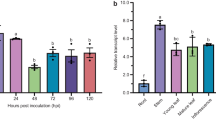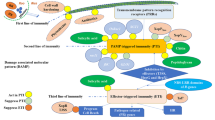Abstract
Botrytis cinerea is a non-specific necrotrophic pathogen that attacks more than 200 plant species. In contrast to biotrophs, the necrotrophs obtain their nutrients by first killing the host cells. Many studies have shown that infection of plants by necrosis-causing pathogens induces a systemic acquired resistance (SAR), which provides protection against successive infections by a range of pathogenic organisms. We analyzed the role of SAR in B. cinerea infection of Arabidopsis. We show that although B. cinerea induced necrotic lesions and camalexin biosynthesis, it did not induce SAR-mediated protection against virulent strains of Pseudomonas syringae, or against subsequent B. cinerea infections. Induction of SAR with avirulent P. syringae or by chemical treatment with salicylic acid (SA) or benzothiadiazole also failed to inhibit B. cinerea growth, although removal of basal SA accumulation by expression of a bacterial salicylate hydroxylase (NahG) gene or by infiltration of 2-aminoindan-2-phosphonic acid, an inhibitor of phenylpropanoid pathway, increased B. cinerea disease symptoms. In addition, we show that B. cinerea induced expression of genes associated with SAR, general stress and ethylene/jasmonate-mediated defense pathways. Thus, B. cinerea does not induce SAR nor is it affected by SAR, making it a rare example of a necrogenic pathogen that does not cause SAR.
Similar content being viewed by others
References
Alexander, D., Goodman, R.M., Gutrella, M., Glascock, C., Weymann, K., Friedrich, L., Maddox, D., Ahlgoy, P., Luntz, T., Ward, E. and Ryals, J. 1993. Increased tolerance to 2 oomycete pathogens in transgenic tobacco expressing pathogenesis-related protein-1a. Proc. Natl. Acad. Sci. USA 90: 7327–7331.
Alvarez, M.E., Pennell, R.I., Meijer, P.J., Ishikawa, A., Dixon, R.A. and Lamb, C. 1998. Reactive oxygen intermediates mediate a systemic signal network in the establishment of plant immunity. Cell 92: 773–784.
Cameron, R.K., Dixon, R.A. and Lamb, C.J. 1994. Biologically induced systemic acquired resistance in Arabidopsis thaliana. Plant J. 5: 715–725.
Chamnongpol, S., Willekens, H., Moeder, W., Langebartels, C., Sandermann, H., Van Montagu, A., Inzé, D. and Van Camp, W. 1998. Defense activation and enhanced pathogen tolerance induced by H2O2 in transgenic tobacco. Proc. Natl. Acad. Sci. USA 95: 5818–5823.
Delaney, T.P., Uknes, S., Vernooij, B., Friedrich, L., Weymann, K., Negrotto, D., Gaffney, T., Gutrella, M., Kessmann, H., Ward, E. and Ryals, J. 1994. A central role of salicylic acid in plant disease resistance. Science 266: 1247–1250.
Delaney, T.P., Friedrich, L. and Ryals, J.A. 1995. Arabidopsis signal transduction mutant defective in chemically and biologically induced disease resistance. Proc. Natl. Acad. Sci. USA 92: 6602–6606.
de Meyer, G. and Hofte, M. 1997. Salicylic acid produced by the rhizobacterium Pseudomonas aeruginosa 7NSK2 induces resistance to leaf infection by Botrytis cinerea on bean. Phytopathology 87: 588–593.
de Meyer, G., Capieau, K., Audenaert, K., Buchala, A., Metraux, J.P. and Hofte, M. 1999. Nanogram amounts of salicylic acid produced by the rhizobacterium Pseudomonas aeruginosa 7NSK2 activate the systemic acquired resistance pathway in bean. Mol. Plant-Microbe Interact. 12: 450–458.
Derckel, J.P., Baillieul, F., Manteau, S., Audran, J.C., Haye, B., Lambert, B. and Legendre, L. 1999. Differential induction of grapevine defenses by two strains of Botrytis cinerea. Phytopathology 89: 197–203.
Durner, J., Shah, J. and Klessig, D.F. 1997. Salicylic acid and disease resistance in plants. Trends Plant Sci. 2: 266–274.
Enyedi, A.J., Yalpani, N., Silverman, P. and Raskin, I. 1992. Localization, conjugation, and function of salicylic acid in tobacco during the hypersensitive reaction to tobacco mosaic virus. Proc. Natl. Acad. Sci. USA 89: 2480–1484.
Falk, A., Feys, B.J., Frost, L.N., Jones, J.D.G., Daniels, M.J. and Parker, J.E. 1999. EDS1, an essential component of R genemediated disease resistance in Arabidopsis has homology to eukaryotic lipases. Proc. Natl. Acad. Sci. USA 96: 3292–3297.
Frye, C.A. and Innes, R.W. 1998. An Arabidopsis mutant with enhanced resistance to powdery mildew. Plant Cell 10: 947–956.
Gaffney, T., Friedrich, L., Vernooij, B., Negrotto, D., Nye, G., Uknes, S., Ward, E., Kessmann, H. and Ryals, J. 1993. Requirement of salicylic acid for the induction of systemic acquired resistance. Science 261: 754–756.
Glazebrook, J., Rogers, E.E. and Ausubel, F.M. 1996. Isolation of arabidopsis mutants with enhanced disease susceptibility by direct screening. Genetics 143: 973–982.
Gorlach, J., Volrath, S., Knauf-Beiter, G., Hengy, G., Beckhove, U., Kogel, K.H., Oostendorp, M., Staub, T., Ward, E., Kessmann, H. and Ryals, J. 1996. Benzothiadiazole, a novel class of inducers of systemic acquired resistance, activates gene expression and disease resistance in wheat. Plant Cell 8: 629–643.
Govrin, E.M. and Levine, A. 2000. The hypersensitive response facilitates plant infection by the necrotrophic pathogen Botrytis cinerea. Curr. Biol. 10: 751–757.
Greenberg, J.T. 1997. Programmed cell death in plant-pathogen interactions. Annu. Rev. Plant Physiol. Plant Mol. Biol. 48: 525–545.
Greenberg, J.T., Guo, A., Klessig, D.F. and Ausubel, F.M. 1994. Programmed cell death in plants: a pathogen-triggered response activated coordinately with multiple defense functions. Cell 77: 551–563.
Guo, A.L., Salih, G. and Klessig, D.F. 2000. Activation of a diverse set of genes during the tobacco resistance response to TMV is independent of salicylic acid; induction of a subset is also ethylene independent. Plant J. 21: 409–418.
Hammerschmidt, R. 1999. Induced disease resistance: how do induced plants stop pathogens? Physiol. Mol. Plant Path. 55: 77–84.
Hunt, M.D., Neuenschwandler, U.H., Delaney, T.P., Weymann, K.B., Friedrich, L.B., Lawton, K.A., Steiner, H.Y. and Ryals, J.A. 1996. Recent advances in systemic acquired resistance research. Gene 179: 89–95.
Hunt, M.D., Delaney, T.P., Dietrich, R.A., Weymann, K.B., Dangl, J.L. and Ryals, J.A. 1997. Salicylate-independent lesion formation in Arabidopsis lsd mutants. Mol. Plant-Microbe Interact. 10: 531–536.
Keller, B., Nierhaus-Wunderwald, D. and Amrhein, N. 1990. Deposition of glycine-rich structural protein in xylem cell walls of French bean seedlings is independent of lignification. J. Struct. Biol. 104: 144–149.
Lawton, K., Weymann, K., Friedrich, L., Vernooij, B., Uknes, S. and Ryals, J. 1995. Systemic acquired resistance in Arabidopsis requires salicylic acid but not ethylene. Mol Plant-Microbe Interact. 8: 863–870.
Lucas, J.A. 1998. Plant Pathology and Plant Pathogens. Blackwell Science, Oxford.
Mauch-Mani, B. and Slusarenko, A.J. 1996. Production of salicylic acid precursors is a major function of phenylalanine ammonialyase in the resistance of Arabidopsis to Peronospora parasitica. Plant Cell 8: 203–212.
Nawrath, C. and Metraux, J. 1999. Salicylic acid induction-deficient mutants of arabidopsis express PR-2 and PR5 and accumulate high levels of camalexin after pathogen. Plant Cell 11: 1393–1404.
Orvar, B.L., McPherson, J. and Ellis, B.E. 1997. Pre-activating wounding response in tobacco prior to high-level ozone exposure prevents necrotic injury. Plant J. 11: 203–212.
Penninckx, I.A.M.A., Eggermont, K., Terras, F.R.G., Thomma, B.P.H.J., De Samblanx, G.W., Buchala, A., Metraux, J.P., Manners, J.M. and Broekaert, W.F. 1996. Pathogen-induced systemic activation of a plant defensin gene in arabidopsis follows a salicylic acid-independent pathway. Plant Cell 8: 2309–2323.
Pieterse, C.M.J., van Wees, S.C., van Pelt, J.A., Knoester, M., Laan, R., H., G., Weisbeek, P.J. and van Loon, L.C. 1998. A novel signaling pathway controlling induced systemic resistance in Arabidopsis. Plant Cell 10: 1571–1580.
Prins, T.W., Tudzynski, P., von Tiedemann, A., Tudzynski, B., Have, A., Hansen, M.E., Tenberge, K. and van Kan, J.A.L. (Eds.). 2000. Infection Strategies of Botrytis cinerea and Related Necrotrophic Pathogens. Kluwer Academic Publishers, Dordrecht, Netherlands.
Reuber, T.L., Plotnikova, J.M., Dewdney, J., Rogers, E.E., Wood, W. and Ausubel, F.M. 1998. Correlation of defense gene induction defects with powdery mildew susceptibility in Arabidopsis enhanced disease susceptibility mutants. Plant J. 16: 473–485.
Ryals, J.A., Neuenschwandler, U.H., Willits, M.G., Molina, A., Steiner, H.Y. and Hunt, M.D. 1996. Systemic acquired resistance. Plant Cell 8: 1809–1819.
Shah, J., Kachroo, P. and Klessig, D.F. 1999. The Arabidopsis ssi1 mutation restores pathogenesis-related gene expression in npr1 plants and renders defensin gene expression salicylic acid dependent. Plant Cell 11: 191–206.
Takahashi, H., Chen, Z., Du, H., Liu, Y. and Klessig, D.F. 1997. Development of necrosis and activation of disease resistance in transgenic tobacco plants with severely reduced catalase levels. Plant J. 11: 993–1005.
Thomma, B., Eggermont, K., Penninckx, I., Mauch-Mani, B., Vogelsang, R., Cammue, B.P.A. and Broekaert, W.F. 1998. Separate jasmonate-dependent and salicylate-dependent defenseresponse pathways in Arabidopsis are essential for resistance to distinct microbial pathogens. Proc. Natl. Acad. Sci. USA 95: 15107–15111.
Thomma, B.P.H.J., Nelissen, I., Eggermont, K. and Broekaert, W.F. 1999. Deficiency in phytoalexin production causes enhanced susceptibility of Arabidopsis thaliana to the fungus Alternaria brassicicola. Plant J. 19: 163–171.
Vernooij, B., Friedrich, L., Morse, A., Reist, R., Kolditzjawhar, R., Ward, E., Uknes, S., Kessmann, H. and Ryals, J. 1994a. Salicylic acid is not the translocated signal responsible for inducing systemic acquired resistance but is required in signal transduction. Plant Cell 6: 959–965.
Vernooij, B., Uknes, S., Ward, E. and Ryals, J. 1994b. Salicylic acid as a signal molecule in plant-pathogen interactions. Curr. Opin. Cell Biol. 6: 275–279.
Weymann, K., Hunt, M., Uknes, S., Neuenschwandler, U., Lawton, K., Steiner, H.Y. and Ryals, J. 1995. Suppression and restoration of lesion formation in Arabidopsis lsd mutants. Plant Cell 7: 2013–2022.
Yamakawa, H., Kamada, H., Satoh, M. and Ohashi, Y. 1998. Spermine is a salicylate-independent endogenous inducer for both tobacco acidic pathogenesis-related proteins and resistance against tobacco mosaic virus infection. Plant Physiol. 118: 1213–1222.
Zhao, J. and Last, R.L. 1996. Coordinate regulation of the tryptophan biosynthetic pathway and indolic phytoalexin accumulation in Arabidopsis. Plant Cell 8: 2235–2244.
Author information
Authors and Affiliations
Rights and permissions
About this article
Cite this article
Govrin, E., Levine, A. Infection of Arabidopsis with a necrotrophic pathogen, Botrytis cinerea, elicits various defense responses but does not induce systemic acquired resistance (SAR). Plant Mol Biol 48, 267–276 (2002). https://doi.org/10.1023/A:1013323222095
Issue Date:
DOI: https://doi.org/10.1023/A:1013323222095




